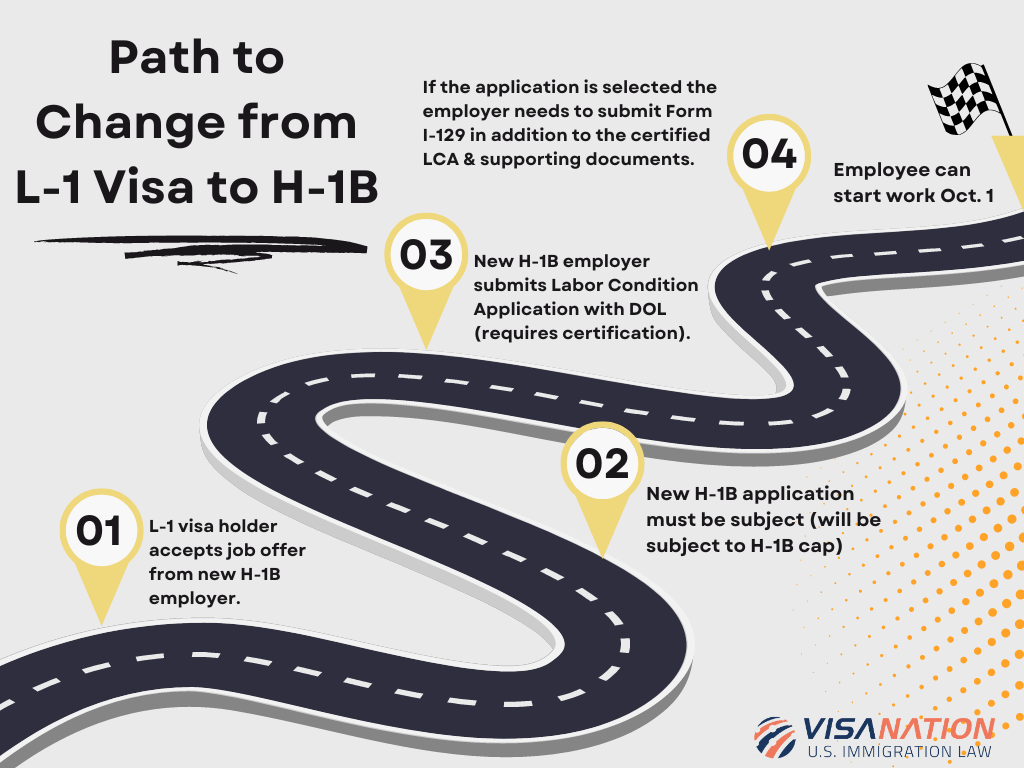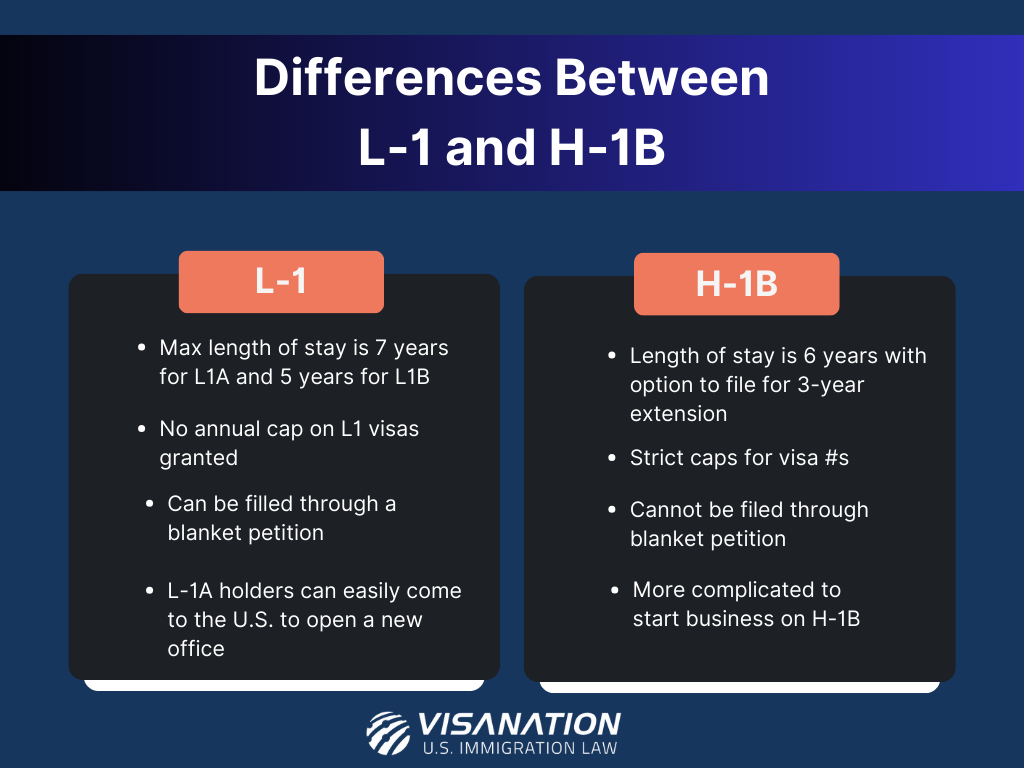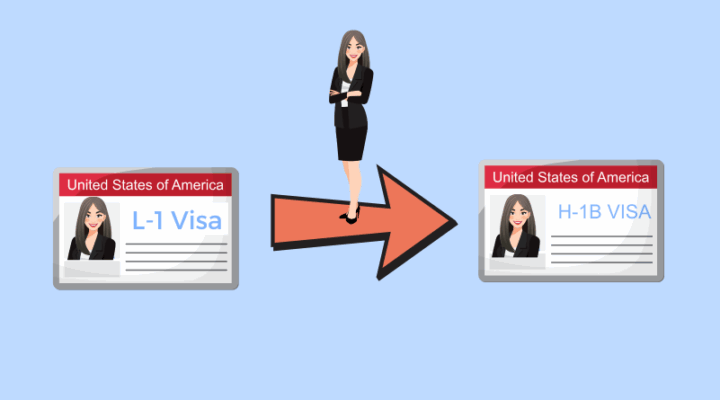Often, foreign professionals find themselves in the United States on an L-1 visa, weighing the pros of converting to an H-1B visa for its multitude of benefits. Having an L-1 visa can be highly advantageous if you work for a multinational company; however, circumstances may require you to change your status from an L-1 visa to an H-1B visa. The two visas share some similarities, but there are distinct differences that might make one better for your situation over the other.
L-1 Visa to H-1B Visa Change of Status
Transitioning from L-1 to H-1B change of status is not all that complicated. Once you find an employer to sponsor you on an H-1B visa, the process is relatively straightforward for an L-1 to H-1B change of status (COS).
The important thing to remember is that there is no special process for converting your status from L-1a or L-1B to H-1B. You will essentially be filing for an H-1B from scratch. The only difference will be that you are already in the U.S., so if your petition is approved, you may not need to go through a consular interview and can instead automatically change your status.
Here is the process:
- L-1 visa holder receives a job offer from a new H-1B employer.
- New H-1B applicants are registered in the H-1B lottery, unless the employer is an exempt organisation such as an institution of higher education, a non-profit that is associated with an institution of higher education, or a governmental research center. If possible, it is good to get a job offer from an employer that falls into one of these cap-exempt categories because your petition will not be subject to the cap.
- If the registration is accepted, the H-1B employer submits a Labor Condition Application with DOL (requires certification).
- After LCA certification, the employer needs to submit Form I-129 in addition to the certified Labor Condition Application, supporting documents, and filing fees.
- Assuming the H-1B visa petition gets approved, you (the employee) can start working on October 1st, and your status will be automatically updated.

L-1 Visa Requirements
The L-1 is a temporary work visa that is meant for the transfer of employees from a multinational company’s foreign branch to a location in the U.S. There are two types of L-1 visas, both of which may be suitable for a change of status to an H-1B.
For L-1A Visa (Managers and Executives):
- Employee must have been working for the foreign company for at least one continuous year within the three years preceding the L-1 visa application.
- U.S. and foreign companies must have a qualifying relationship, such as parent and subsidiary, branch, or affiliate.
- Employee must be coming to the U.S. to work in a managerial or executive capacity.
- U.S. company must have a physical office or location in the U.S.
For L-1B Visa (Employees with Specialized Knowledge):
- Employee must have been working for the foreign company for at least one continuous year within the three years preceding the L-1 visa application.
- U.S. and foreign companies must have a qualifying relationship, such as parent and subsidiary, branch, or affiliate.
- Employee must possess specialized knowledge that is not readily available in the U.S. labor market.
- U.S. company must have a physical office or location in the U.S.
If you are selected in the H-1B visa lottery, contact VisaNation attorneys for filing your H-1B petition.
H-1B Requirements
The H-1B, on the other hand, is not limited to multinational companies, which is what makes it such a popular visa option.
- Job Offer – Applicant must have a job offer from a U.S. employer for a position that qualifies as a specialty occupation.
- Specialty Occupation and Education – The position must require specialized knowledge and a minimum of a bachelor’s degree or equivalent work experience in a related field.
- Education – The applicant must possess at least a bachelor’s degree or its equivalent work experience in the specific field related to the H-1B job.
- Employer–Employee Relationship – There must be a valid employer-employee relationship between the petitioner (U.S. employer) and the beneficiary (H-1B visa applicant).
- Labor Condition Application (LCA) – The U.S. employer must file an LCA with the Department of Labor, attesting to compliance with labor standards and prevailing wage requirements.
- Wage Requirements – The employer must agree to pay the H-1B visa holder the prevailing wage for the specific occupation in the geographic area where the work will be performed.
Similarities Between L-1 and H-1B
Both L-1 and H-1B are temporary (non-immigrant) visas that allow dual intent. In this case, dual intent means that the foreign worker does not need to demonstrate ties to the home country or jeopardize their visa status by filing for a green card.
They both are available for premium processing. The premium processing fee of $2,805 and checks should be made payable to the U.S. Department of Homeland Security. USCIS guarantees that premium processing cases will be handled within 15 business days. If you receive a request for evidence (RFE) or other additional paperwork then an additional 15-day period will begin for processing once USCIS receives those documents.
President Trump has signed a new proclamation introducing a $100,000 fee for new H-1B petitions. This change could impact employers and foreign workers planning to apply, but exclusions apply.Read our full article for more details
The spouse of an L-1 visa holder (L-2) receives automatic work authorization, as it is “incident to status.” In contrast, relatives of H visa holders may be eligible to get an EAD if their spouse is the principal beneficiary of an approved Form I-140, Immigrant Petition for Alien Worker.
Selected in the H-1B visa lottery? Contact VisaNation attorneys for filing your H-1B petition.
Differences Between L-1 and H-1B
The maximum length an individual can remain in the U.S. on an L-1 is seven years (L-1A) and five years for L-1B. In contrast, an H-1B status holder can stay for six years with the option to file for a three-year extension. For individuals who spend time outside the country on an H visa, that duration is subtracted from the maximum amount of the L visa (or vice versa).
L-1A holders can easily come to the U.S. to open a new office (though visas in this case are issued for an initial period of one year). Although it is possible to start a business on an H-1B visa, it is more complicated, and there are no special provisions for it.

L-1 to H-1B Cap Exempt
One of the disadvantages of the H-1B among all other nonimmigrant visas is the fact that it is subject to the annual cap and lottery. However, not all H-1B petitions fall under this cap. H-1B transfers and extensions are cap-exempt, and so are petitions filed for certain cap-exempt employers. This last part is important if you are an L-1 visa holder seeking to avoid the cap.
There are three types of employers that are not subject to the cap:
- Institutions of higher education
- Non-profit organizations that are associated with institutions of higher education, and;
- Nonprofit Research Organizations or Governmental Research Organizations
If you can get a job offer from an employer that falls into one of these categories, your petition will not be subject to the cap.
This means that it can be submitted at any time (not just the first business day in April, like cap-subject petitions), and you do not have to wait until October 1st to begin working as an H-1B employee.
However, this is not an effective way to circumvent the cap and work for a different employer. If you file to transfer your H-1B status from a cap-exempt employer to a cap-subject one, you will need to enter your petition into the lottery and be restricted to the designated time period.
If you are selected in the H-1B visa lottery, contact VisaNation attorneys for filing your H-1B petition.
Process of L-1 to H-1B Change of Status
The H-1B season, starting in April, operates as a lottery system, with cap-subject petitions categorized into Master’s (20,000) or Regular Quotas (65,000). Planning is crucial, especially for those not on H-1B status previously, as an annual cap applies.
The sponsoring employer files the petition, including an employment letter with duties, employment dates, and prevailing wage details. The Labor Certification Application, involving four attestations to the Department of Labor, is the next step:
- Confirmation of prevailing wage payment.
- Assurance of no negative impact on current employees.
- Notification to current employees about the new hire.
- Confirmation of no ongoing strike or lockout.
Once approved, the DOL provides a certified copy. Submit all necessary documents to the USCIS service center, with the employer covering fees (except premium processing).
If selected in the lottery and approved, H-1B employment begins after October 1st, automatically changing nonimmigrant status. Remember, the beneficiary cannot pay fees by law, but personal gain can justify the premium processing fee.
Learn about H-1B Visa Stamping in this guide.
Can You Change Your L-1 to H-1B With the Same Employer?
As long as your L-1 employer can be considered a U.S. employer and can offer you a specialized position, you should be able to have that employer sponsor you for an H-1B. However, keep in mind that an employer with too many H-1B workers may be considered H-1B dependent.
Also, remember that you need a bachelor’s degree that is related to your specialized H-1B job. Not all L-1 positions qualify you for an H-1B. Be sure to have your immigration attorney review your case and determine whether or not your position qualifies.
Can you go from L-1B to H-1B without lottery?
Yes, it is possible to go from an L-1B Visa to H-1B without participating in the H-1B Lottery. However, this is only possible when the role is sponsored by a cap-exempt organization. If the organization is not cap-exempt, you must go through the H-1B lottery.
 Shilpa Malik
Shilpa Malik  Sabrina Saada
Sabrina Saada 
